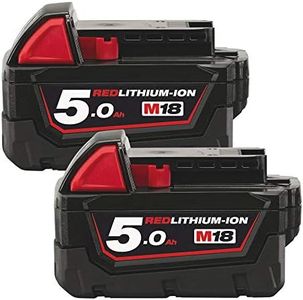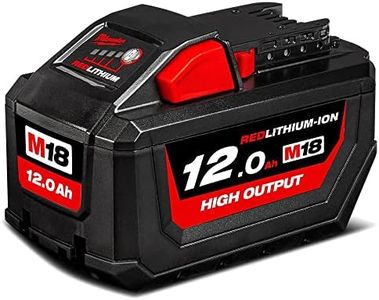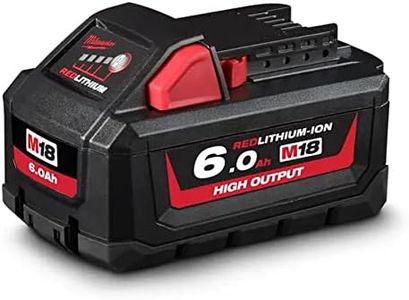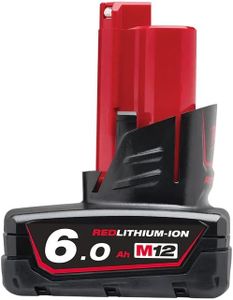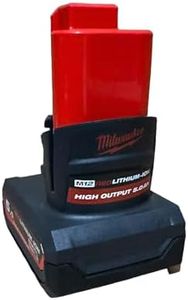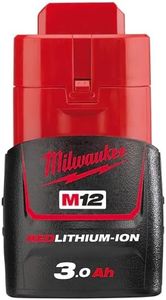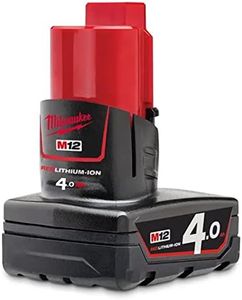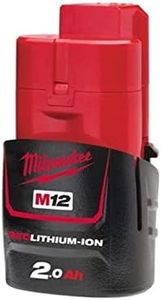We Use CookiesWe use cookies to enhance the security, performance,
functionality and for analytical and promotional activities. By continuing to browse this site you
are agreeing to our privacy policy
9 Best Milwaukee Battery
From leading brands and best sellers available on the web.Buying Guide for the Best Milwaukee Battery
Choosing the right battery is crucial for getting the most out of your Milwaukee power tools. The battery you select affects not only how long you can use your tool on a single charge, but also its power, size, and convenience. Since Milwaukee makes a range of batteries for different uses, understanding the specifications will help you tailor your purchase to your needs, whether you’re a weekend DIYer or a frequent user on job sites.Voltage (V)Voltage is a measure of the battery’s power potential, affecting how much strength the tool can deliver. Milwaukee batteries commonly come in voltages like 12V or 18V. Lower voltage batteries (like 12V) are usually lighter and work well for lighter tasks such as assembly, repairs, or jobs where portability matters. Higher voltage batteries (18V and above) offer more power and are better suited for heavy-duty tools and demanding tasks, such as drilling into masonry or cutting thick wood. Think about the type of work you do most often to determine if portability or power is your priority.
Amp-Hour (Ah) RatingAmp-hour, often written as Ah, tells you how much charge the battery holds and directly influences how long you can use your tool before needing a recharge. Lower Ah batteries (under 3.0Ah) are usually lighter and charge faster, ideal for shorter tasks or when frequent battery changes aren’t a problem. Higher Ah batteries (4.0Ah and above) can run much longer between charges, great for long projects or heavy tool use, though they add weight. If you often perform lengthy tasks or want fewer interruptions, choose a higher Ah. For casual or lighter work, a lower Ah could be more convenient.
Battery Size & WeightThe physical size and weight of a battery impact how comfortable your tool is to use, especially for extended periods or overhead work. Compact batteries are smaller and lighter, making the tool less tiring to handle but offering less run time. Extended or high-capacity batteries are bulkier and heavier but can run your tool longer. For jobs that require a lot of movement or working in tight spaces, a compact battery may be best, while for stationary, rigorous jobs, the size and weight of a large battery may be worth the longer run time.
Compatibility (Tool Line/Platform)Not all Milwaukee batteries fit all their tools—each battery is designed for a specific series like M12 or M18, which matches the voltage system of your tools. Using the wrong battery line won’t work, so always check that the battery matches your tool family. If you already have tools from a certain platform (M12 for compact tools or M18 for bigger ones), make sure you choose batteries from that same line for maximum versatility.
Type of Battery Cells (Standard vs. High Output)Milwaukee offers batteries with standard cells and newer 'high output' versions. High output batteries use improved technology to provide longer run time, cooler operation, and more consistent power, especially in demanding applications. They can handle tougher jobs without overheating, but standard batteries are perfectly fine for regular, light to moderate use. If you frequently do heavy work or use high-demand tools, high output batteries could be a worthwhile choice. Otherwise, standard batteries will meet most users’ needs.
Charging TimeHow long a battery takes to recharge can influence your workflow, especially if you have only one or two batteries. Some batteries charge faster due to their size or advanced cell technology. If quick turnaround is important to you, check for batteries designed with rapid charge capabilities, but remember this may also require a compatible fast charger. For lighter or occasional use, standard charging times are usually sufficient.
